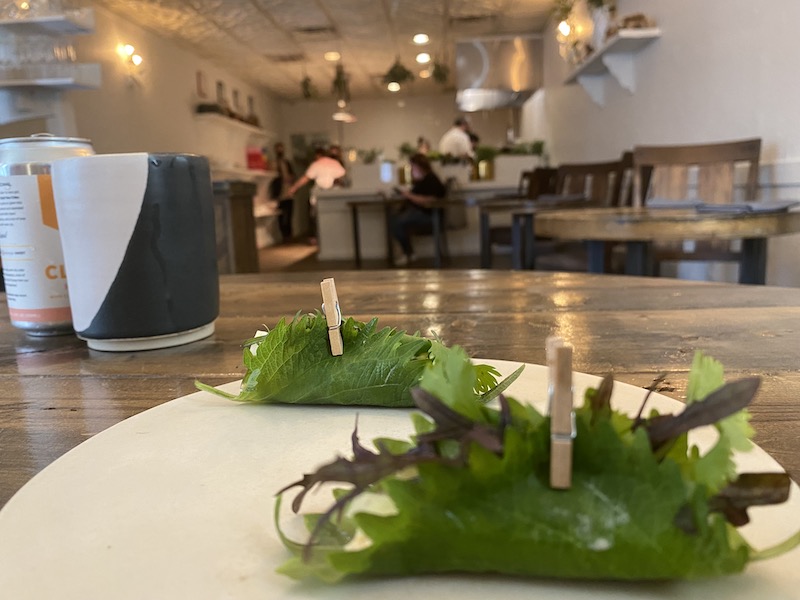1. ALL RAMEN IS BI-SON
Nick Kindelsperger tells the weird story of how we wound up with a rare beefy style of ramen made even rarer by the specific quadruped involved. Meet bison ramen at Gyuro Ramen:
Gyukotsu ramen turns out to be rare even in Japan, though it apparently has some popularity in the Tottori Prefecture, located in the southern part of the country. Needless to say, it’s extraordinarily rare in the United States, with only a handful of restaurants across the country currently serving the style. According to [owner Kenny] Yang, part of the scarcity comes down to cost. “Beef bones are much more expensive than pork bones, especially in Japan,” he said.
Yang also said his first experiments with beef bones didn’t taste right. The broth tasted flabby, and the color wasn’t what he wanted. That’s when he noticed a local meat supplier had bison bones. “The company had no use for the bison bones,” Yang said. “We tested them, and the broth came out so much better. It’s mild compared to the broth made with beef bones, plus they are cheaper.”
2. WAH SUP
As venerable Chinese-American place House of Wah Sun (not to be confused with Sun Wah) plans to move from north Lincoln Avenue to a shuttered Golden Nugget, Mike Sula talks to the family behind the 75-year-old restaurant:
Customers are invariably greeted inside the doors by a giddy dancing wooden Buddha, and in contrast, [co-owner Young Ja] Kim, whose MO is initially stern but ultimately endearing. There’s a full bar known for its sweet, potent Mai Tais and Zombies in ceramic tiki ware, and a sprawling menu that covers all the classic Chinese American bases and then some.
3. WHAT’S IN MILWAUKEE NOW
Titus Ruscitti has been visiting Milwaukee lately, it appears, as he has a bunch of capsule reviews from Chicago’s alternate universe:
It’s been quite a while since I checked in with a report from the Brew City aka Cream City. But I’ve visited plenty of times since then so it’s time for a new roundup on what’s good in what I like to call my “favorite Chicago suburb” which is a slight joke but it’s proximity to here makes it my favorite spot to spend a day within two hours of Chicago. I’ve always considered Milwaukee a mini Chicago or a little sibling of sorts since it’s so similar to the Chicago I remember as a kid. But Milwaukee is less gentrified and less developed in terms of new buildings replacing old ones so it really does bring back memories of the Chicago where there was a tavern on every corner and such. Plus it sits on the same lake so lots Milwaukee’s lakefront is similar to Chicago right down to the rich peoples suburbs being north of the city. There’s no spot outside of Chicago I feel more at home in than Milwaukee.
4. TOBY JUG
Lisa Futterman talks to Toby Maloney of The Violet Hour about his new book on cocktails:
He shares what they call their Mother Drinks, five cocktail templates “that every bartender needs to open the door for invention to follow.” Once those five — The Sour, The Old-Fashioned, The Martini/Manhattan, The Vieux Carré and The Negroni — are mastered, the other 100 original drink recipes in the book may be tackled.
5. BALLER TIME
At NBC 5, Steve Dolinsky talks special occasion dining, including Maple & Ash, the Omakase Room at Sushi-San, and Bazaar Meat.
6. THE BIG VALLEY
Grimod uses the concept of the uncanny valley—when something like a robot is attempting to replicate the look of something human, but the falling short is what we find disturbing—to discuss why service sometimes seems unnervingly fake:
Once the illusion of a pleasant “night out” is punctured—even due to the most innocent interaction—the diner begins to assume bad faith. The kind of mediocrity that, typically, is safely absorbed by the peak-end rule is now given the spotlight. Every gesture, every inflection in tone is subject to scrutiny. They all serve to feed a gnawing feeling of alienation while remaining too subtle to provoke vocal protest. Rather, the customer is drawn into an “us vs. them” mentality that sees themself as being dehumanized by a strangely subpar, almost contrived practice of service that violates their expectations of social and environmental appeal. The food, unless obviously flawed, will be perceived in accordance with the disappointment felt across the rest of the experience. Even stellar flavors will see their degree of delectation deflated.
7. REPAIRING THE BIG GUY
Last week I mentioned Brendan O’Connor’s GoFundMe in support of Big Guys Sausage Stand; this week Oak Park’s Wednesday Journal has a piece on what they’re doing to get the stand, a former Parky’s location, up and running again:
The closure itself puts Big Guys in a financial bind, but it is just another issue among many plaguing the decade old establishment. When restaurant dining rooms reopened after pandemic related closures, sales slumped significantly. O’Connor notes they were busy during the height of the pandemic when people were looking for family meals and carry out fare, but now that people are dining inside again demand for Big Guys’ family meals evaporated and fewer walk-in customers visit the Veltway mainstay. When business picks up staffing shortages make it impossible to keep up with demand. In response O’Connor said he has been forced shut down delivery apps and stop taking phone orders.
8. METAJERKS
Facebook allowed hackers to screw over Geneva’s Bien Trucha and its sibling restaurants, and wouldn’t respond to attempts to fix it—even when the Chicago Tribune came calling. (It looks like it got fixed, after the story ran.)
9. SLUGWORTHY
I’d vaguely heard of Slugburgers, a sort of proto-Hamburger Helper patty common in Mississippi. Sandwich Tribunal finds the slugs to make it. No, the beef is not extended with actual slugs:
It was not until years later that the name slugburgers caught on, based not on any perceived textural deficiency of the extended burgers, or on any suspicious of their content, but based, perhaps apocryphally, on their price. “Slug” is not only the name for a type of snail without a shell but has been used since the 19th Century to describe counterfeit coins. At some point this meaning was extended to include the American 5 cent piece otherwise called a nickel, and Corinth town lore says that the Weeksburger went for a nickel apiece during the Depression, hence the name. Incidentally, though the term “slugburger” centers mostly around Corinth in northern Mississippi, Elvis Presley enjoyed a similar treat called a “doughburger” growing up in his hometown of Tupelo, 50 miles south.
10. STIX NIX HIX PIX
Best headline of the week, from Eater: Maple & Ash Investors File Lawsuit Against Owners Who Are Already Suing Each Other
WHAT MIKE ATE
One of the items I always hunted for during Fooditor’s weekly run of feature stories was something I could genuinely call, at that moment, “The best restaurant you’ve never heard of.” The goal was an unusually solid and thoughtful restaurant that somehow had not gotten any notable publicity up to that point—no reviews, no stories about the chefs, at most only Yelp reviews. In five years I only found three that I thought had the highest combination of excellence and obscurity—Arbor, Royal Grocer (which, alas, changed almost immediately) and Munno (the only survivor in its Fooditor-acclaimed form).
I have a new one: Elizabeth.
Wait, you say, do I mean the Iliana Regan Elizabeth? Everybody knows about that! And indeed they did, but Regan has gone off to Michigan to run her glamping adventure Milkweed Inn, and Elizabeth was taken over by a new owner named Tim Lacey, who Regan knew dating back to when she worked at Trio, and a chef named Ian Jones, who worked at Band of Bohemia (not to be confused with one-time Band of Bohemia chef Ian Davis), NoMI and Bavette’s. Both worked with/for her at Kitsune.
Lacey took over ownership permanently last fall. And it’s that Elizabeth that, so far as I can tell, has not been written about critically by anybody—no reviews, no feature stories, no mentions in “what’s happening” pieces. If you look at the “press” section on Elizabeth’s website, it’s all old pieces about Regan, the most recent being a 2020 New York Times piece about Regan leaving it all behind to move to Michigan. At that point her plan was to close Elizabeth for good; Lacey and Jones were nowhere in the picture.
Well, somebody needs to set that straight, two years later. Elizabeth 2022, if not quite as magically weird as Regan’s faerie-Goth Elizabeth, is wonderful in its own ways, the kind of playfully imaginative—and no small thing, delicious—tasting menu restaurant with a chef’s personal outlook that a decade ago, when there was food media, would have been a food media darling. Some people clearly have found out about it—on the Thursday I went, it was mostly full, if not solidly booked as Regan’s version regularly was—but nobody’s written about it. I don’t just mean mainstream publications; a bit poignantly, at LTHForum, poster “GAF,” who coined the descriptor Regan used for her approach (“New Gatherer Cuisine”) but had moved away at the time, was left asking some months back if anybody had been yet.
According to the website, it’s still “New Gatherer Cuisine,” and that was demonstrated throughout the evening by mentions of things grown on the rooftop and gathered after work by the chefs (and by the presence of ingredients like mulberries and juneberries you can’t really buy commercially, but can find wild easily enough in the Chicago area). Spring peas, a shortlived delight in June this year, figured repeatedly, but so did cherry tomatoes, which were treated three different ways and then submerged in a bacalao puree, and asparagus alongside almond-ricotta gnudi.
But midwestern foraged food isn’t the only note they play; there’s a Japanese-ish influence to the seafood that recalls Kitsune, most obviously in a dish built on hokkaido scallops, which were delicate and sweet and served with salmon roe and sea grapes; umeboshi (salted plum) found its way into that bacalao dish, and there was a canteloupe gazpacho with hints of Midori liqueur, which was wonderfully bright and refreshing. Much of that was playful and quite refined, but other dishes were earthy—like a rabbit sugo with shaved grana padano—and one was outright funny, reminiscent of Regan’s themed dinners and long-ago things like Next’s Childhood menu—a “fried bologna sandwich” of housemade mortadella on a housemade milkbread bun, served with a “juicebox” of verjus.
Throw in housebaked bread at a couple of points, carrying on Regan’s history of baking, and we were quite full by the end, so the three dessert courses (a yuzu granita, a course of foraged berries, many of them lightly smoked, and an uni ice cream course at the end—well, except for mignardises at the end end) were all brightly and lightly refreshing, the right touch for a close.
Even under black masks on all the staff, service (mainly led by two women, one of whom also served as the somm) was extremely friendly and congenial. (I don’t know anyone there, but perhaps they knew my name, because we were comped one extra course.) I was there with my wife and my mom, visiting Chicago after COVID for the first time in years, and I picked it a bit blindly, out of curiosity about what the new incarnation of Elizabeth was like. In the end, it was a great choice for blowing mom’s mind and pleasing us all with inventive, well-crafted food in an intimate setting, and a place I can recommend for its personal touches and unique outlook in a neighborhood spot where the chefs cook right in front of you—precisely what so many of us loved about a place called Elizabeth a decade ago.
See more photos from Elizabeth at my Instagram account here.



